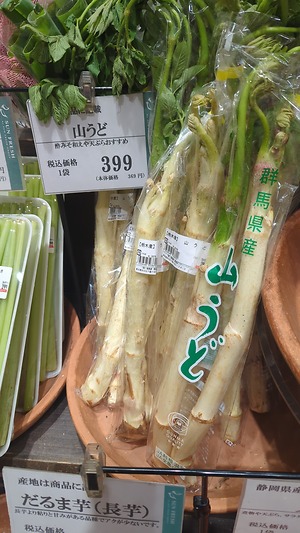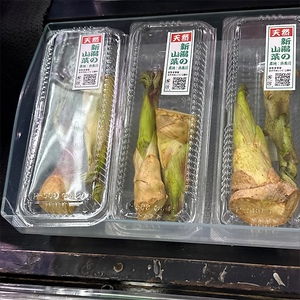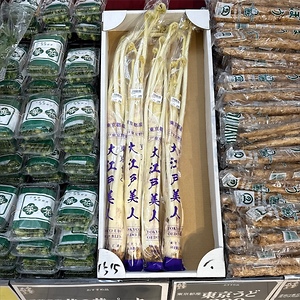


Yama Udo
Estimated Inventory, lb : 0
Description/Taste
Yama Udo is comprised of thick, straight, and fleshy, upright stems averaging 60 to 90 centimeters in length and 2 to 5 centimeters in diameter. The wild, edible shoots have a tough, fibrous, astringent skin that is unpalatable when raw and peeled before culinary use. The skin also showcases variegated pale green, pink, red, and yellow-green hues and is covered in rigid knots and bristle-like hairs. Underneath the surface, the white to pale green flesh is solid, tender, and crisp with a succulent consistency. The flesh oxidizes quickly and discolors after slicing or peeling. Yama Udo releases a distinct earthy aroma and should have a firm, clean, and crunchy nature. The flesh has a fresh, green, and vegetal flavor with a subtle bitterness and nuances reminiscent of fennel, celery, and chicory.
Seasons/Availability
Yama Udo is available in the spring through early summer. Cultivated forms of Udo are found in markets from mid-winter through early summer.
Current Facts
Yama Udo, botanically classified as Aralia cordata, is a wild, ancient species belonging to the Araliaceae family. The herbaceous perennial is native to East Asia and is tall and upright, reaching 2 to 3 meters in height in ideal environments. Despite their capacity to grow to large sizes, Yama Udo is seasonally harvested for its young and tender stems. The stems are incorporated into lightly cooked culinary preparations and are viewed as a seasonal delicacy, especially in Japan, where they are known as a sansei or traditional mountain vegetable. Yama Udo translates to "mountain vegetable," and the species is also known as Udo, Japanese Spikenard, and Mountain asparagus. Historically, Yama Udo was challenging to find and was a rare springtime ingredient, but in the modern day, it has been selected for commercial production, extending the plant's availability. Cultivated Udo is known as Nanka Udo, meaning "softened Udo," and is also labeled as White Udo or Soft White Udo. The cultivated plants are either sown in greenhouses under controlled lights, planted in ditches, and covered in soil, or produced in dark caves. Growing Udo in dark conditions allows the young stems to develop a tender, soft, but still crisp consistency and a mild, less astringent, and sweeter flavor. Cultivated stems also can be eaten raw and do not require peeling, unlike the wild-harvested Yama Udo. In Japan, wild Yama Udo is rare in markets and is only found for a few months in the spring. Most of the Udo sold in commercial markets are cultivated plants, sometimes exposed to the sun before sale, to make the stems appear similar to the foraged types. Yama Udo is collected and sold outside of Japan as a springtime vegetable in Korea and China. It is also sourced for its roots and incorporated into various medicinal remedies.
Nutritional Value
Yama Udo is a source of potassium to balance fluid levels within the body, fiber to regulate the digestive tract, vitamin C to strengthen the immune system, and other nutrients, including copper, calcium, iron, zinc, magnesium, and phosphorus. The young stems are also a source of hydration, containing a high water content, and provide diterpene aldehyde, chlorogenic acid, and aspartic acid. Diterpene aldehyde gives the stems their unique scent and stimulates blood circulation, while chlorogenic acid is a type of polyphenol with antioxidant properties to reduce inflammation. Aspartic acid is an amino acid that reduces fatigue and increases metabolism. In traditional medicines of China, Korea, and Japan, the dried root of Yama Udo is ground into a powder, mixed into tinctures, or steeped into tea as a method to calm the body, lessen joint pain, and lower fevers. The dried root also has a bitter, warm, and pungent nature that can expel dampness and heat from the body.
Applications
Yama Udo has a vegetal, green, and subtly bitter flavor suited for cooked preparations. Wild-harvested Yama Udo has a thick, tough, and astringent skin that contains a resin that is unpleasant to consume raw. The stems are traditionally peeled, soaked in a mixture of vinegar and water, and then lightly cooked to create an enhanced eating experience. It is important to note that some cultivated forms of Udo can be eaten raw as they are grown in a process that removes the tough, bitter skin. These cultivated stems can be thinly sliced and added to salads or mixed with sauces and herbs as a fresh side dish. Yama Udo is extensively used in Japanese cuisine as a seasonal springtime ingredient, and the stems are often blanched in vinegar miso for added flavoring. The stems can also be fried into tempura or grilled and served as a simple side dish. In addition to the stems, the peeled skin of Yama Udo can be used in kinipira, where the skins are fried and combined with soy sauce, miso, ginger, vinegar, and water as an appetizer. In China, Yama Udo is simmered into soups, stir-fried as a vegetable, or blanched and served with meat. In Korea, the stems are pickled as a tangy condiment, added to stews, or blanched and seasoned with scallions, garlic, soy sauce, sesame oil, and sesame seeds in a variation of namul. They are also made into jeon by blanching, dredging the stem pieces in a mixture of starch and egg wash, and pan-frying. Yama Udo pairs well with herbs such as lemongrass, coriander, chives, and perilla, aromatics including ginger, garlic, shallots, and chile peppers, and seafood such as fish, scallops, and shrimp. Whole, unwashed Yama Udo should be immediately used for the best quality and flavor. The stems can be wrapped in newspaper and stored in the refrigerator for 1 to 2 days, but if exposed to light, white Udo stems may turn green and discolor. Yama Udo can also be frozen for approximately one month.
Ethnic/Cultural Info
Yama Udo is used in a common Japanese expression, "Udo no taiboku hashira ni narazu," meaning "great trees are good for nothing but shade." This expression is also referred to as "the large tree of Udo" and refers to Yama Udo's inability to be used after it grows too large. Yama Udo is only consumed when it is young, and once it matures, the stems become too large and tough to eat. Despite the plant's tall nature, the stems are considered too soft to use as wood, rendering the mature Yama Udo useless. The Japanese expression uses Yama Udo as a metaphor for someone who is large and lazy, making them useless to society. Beyond its cultural uses, there is a rare type of Yama Udo increasing in popularity and grown using specialized methods in Tokyo. The Udo variation is known as Tokyo Udo and is a type of softened Udo cultivated in underground holes. The cultivation process was invented in Musashino in 1946 and was introduced to Tokyo, specifically Tachiawa, a city in the western metropolis, in 1955. Growers dig small holes in the ground about 2 to 3 meters down from the surface and create a small cavern with just enough room for the plants to grow to harvestable lengths. Producing Tokyo Udo is labor-intensive, uncomfortable, and challenging as temperature and light are consistently monitored for ideal conditions. Once the stems have reached a favorable height, they are hand-harvested and packaged for immediate sale. Tokyo Udo is white when harvested and has a mild, tender, crisp, and succulent consistency, especially favored for raw preparations to savor its subtle and delicate nature. The specialty crop is valued for its gourmet qualities, distinct from other commercial Udos, and Tachiawa city is known for its rich soils, leading Tokyo Udo to be a niche crop only successfully grown in the city limits.
Geography/History
Yama Udo is native to East Asia, specifically Japan, Korea, and China, and has been growing wild since ancient times. The plant is believed by experts to have been present since the Jomon period in Japan, spanning from 10,500 to 8,000 BCE, and the young stems were seasonally gathered as a treasured culinary ingredient. Other records of Yama Udo in Japan are connected to the Nara period, where ruins encased several wooden strips with the word "dokukatsu" written on the strips, meaning "grows by itself." Dokukatsu is the name for the Kanji character used for Yama Udo. The plants were also mentioned in cookbooks written in the Heian period, and in the Edo period, Yama Udo was selected for cultivation, improving the characteristics of the plants through natural breeding. In the early 20th century, experts mentioned that Yama Udo was sent to the United States for possible production, but the young stems never became a popular item. In the wild, Yama Udo thrives in moist, rainy climates with some shade and is found on the slopes of embankments, in fields, and on mountains. Today Yama Udo can be found in the Akita, Kyushu, Tochigi, Honshu, Gunma, Hokkaido, Shikoku, Yamagata, Saitama, and Ibaraki Prefectures. Cultivation of Nanka Udo or Softened Udo is primarily conducted in the Tochi and Gunma prefectures, followed by Akita and Tokyo. Outside of Japan, Yama Udo is planted throughout China in Fujian, Hubei, Guangxi, Jiangxi, Jiangsu, and Anhui, and grows naturally in forests in Korea and Taiwan. When in season, Yama Udo is found in fresh markets, direct from growers, or in limited quantities through specialty grocers.










